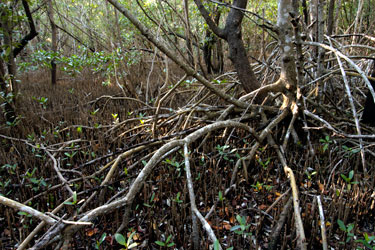
|

Mangrove Forest
The mangrove forest forms the buffer zone between the freshwater prairies of the interior Everglades and the saltwater
As the forest extends inland, black mangroves begin to dominate the forest canopy. These trees get their name from their dark black trunks which make them easily identifiable. Instead of prop roots, black mangroves have root extensions, known as pneumatophores, which protrude up through the surface of the soil and act as a site of gas exchange and a way for the black mangrove to release excess salt. The forest floor under a black mangrove is thick with these pneumatophores that allow the tree to survive in such harsh conditions. The white mangroves and buttonwoods can be found anywhere in the forest but are most common on higher ground where flooding is less frequent. Unlike the extreme adaptations of the black and red mangroves the white mangroves have similar but much more subtle adaptations. All of these species help to protect coastal portions of the region during storms and high surf. The prop roots of the red mangrove and the pneumatophores of the black mangrove are specially adapted to provide support for the tree as well as secure soil around the roots. During calmer conditions these roots also help to trap sand and debris and help in land formation. These important functions, coupled with the formation of estuaries and their importance to hundreds of marine fish species, make the mangrove forest one of the most important communities in the region. |
